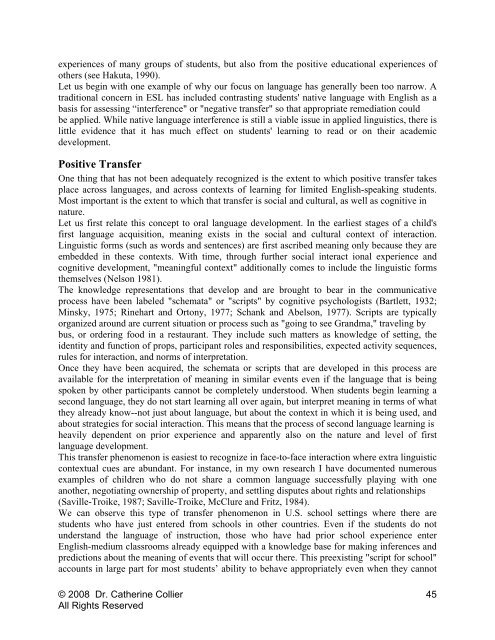Art Un ticle I.1 ited Sta In the ates News - Woodring College of ...
Art Un ticle I.1 ited Sta In the ates News - Woodring College of ...
Art Un ticle I.1 ited Sta In the ates News - Woodring College of ...
- No tags were found...
Create successful ePaper yourself
Turn your PDF publications into a flip-book with our unique Google optimized e-Paper software.
experiences <strong>of</strong> many groups <strong>of</strong> students, but also from <strong>the</strong> positive educational experiences <strong>of</strong>o<strong>the</strong>rs (see Hakuta, 1990).Let us begin with one example <strong>of</strong> why our focus on language has generally been too narrow. Atraditional concern in ESL has included contrasting students' native language with English as abasis for assessing “interference" or "negative transfer" so that appropriate remediation couldbe applied. While native language interference is still a viable issue in applied linguistics, <strong>the</strong>re islittle evidence that it has much effect on students' learning to read or on <strong>the</strong>ir academicdevelopment.Positive TransferOne thing that has not been adequately recognized is <strong>the</strong> extent to which positive transfer takesplace across languages, and across contexts <strong>of</strong> learning for lim<strong>ited</strong> English-speaking students.Most important is <strong>the</strong> extent to which that transfer is social and cultural, as well as cognitive innature.Let us first relate this concept to oral language development. <strong>In</strong> <strong>the</strong> earliest stages <strong>of</strong> a child'sfirst language acquisition, meaning exists in <strong>the</strong> social and cultural context <strong>of</strong> interaction.Linguistic forms (such as words and sentences) are first ascribed meaning only because <strong>the</strong>y areembedded in <strong>the</strong>se contexts. With time, through fur<strong>the</strong>r social interact ional experience andcognitive development, "meaningful context" additionally comes to include <strong>the</strong> linguistic forms<strong>the</strong>mselves (Nelson 1981).The knowledge representations that develop and are brought to bear in <strong>the</strong> communicativeprocess have been labeled "schemata" or "scripts" by cognitive psychologists (Bartlett, 1932;Minsky, 1975; Rinehart and Ortony, 1977; Schank and Abelson, 1977). Scripts are typicallyorganized around are current situation or process such as "going to see Grandma," traveling bybus, or ordering food in a restaurant. They include such matters as knowledge <strong>of</strong> setting, <strong>the</strong>identity and function <strong>of</strong> props, participant roles and responsibilities, expected activity sequences,rules for interaction, and norms <strong>of</strong> interpretation.Once <strong>the</strong>y have been acquired, <strong>the</strong> schemata or scripts that are developed in this process areavailable for <strong>the</strong> interpretation <strong>of</strong> meaning in similar events even if <strong>the</strong> language that is beingspoken by o<strong>the</strong>r participants cannot be completely understood. When students begin learning asecond language, <strong>the</strong>y do not start learning all over again, but interpret meaning in terms <strong>of</strong> what<strong>the</strong>y already know--not just about language, but about <strong>the</strong> context in which it is being used, andabout strategies for social interaction. This means that <strong>the</strong> process <strong>of</strong> second language learning isheavily dependent on prior experience and apparently also on <strong>the</strong> nature and level <strong>of</strong> firstlanguage development.This transfer phenomenon is easiest to recognize in face-to-face interaction where extra linguisticcontextual cues are abundant. For instance, in my own research I have documented numerousexamples <strong>of</strong> children who do not share a common language successfully playing with oneano<strong>the</strong>r, negotiating ownership <strong>of</strong> property, and settling disputes about rights and relationships(Saville-Troike, 1987; Saville-Troike, McClure and Fritz, 1984).We can observe this type <strong>of</strong> transfer phenomenon in U.S. school settings where <strong>the</strong>re arestudents who have just entered from schools in o<strong>the</strong>r countries. Even if <strong>the</strong> students do notunderstand <strong>the</strong> language <strong>of</strong> instruction, those who have had prior school experience enterEnglish-medium classrooms already equipped with a knowledge base for making inferences andpredictions about <strong>the</strong> meaning <strong>of</strong> events that will occur <strong>the</strong>re. This preexisting "script for school"accounts in large part for most students’ ability to behave appropriately even when <strong>the</strong>y cannot© 2008 Dr. Ca<strong>the</strong>rine CollierAll Rights Reserved45
















